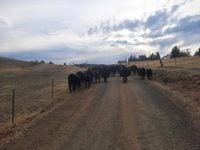It’s been a tumultuous autumn for the American beef industry, with prices at record highs, ranchers caught in the crosshairs of political maneuvering, and the federal government launching a sweeping antitrust investigation into the nation’s dominant meatpackers. The situation has left everyone from grocery shoppers to cattle ranchers to politicians on edge, each group grappling with the complex forces shaping the price of America’s favorite protein.
On November 26, 2025, President Donald Trump directed the Department of Justice (DOJ) to open a formal probe into the four largest beef processors in the United States—JBS, Cargill, Tyson Foods, and National Beef—accusing them of potential collusion, price-fixing, and price manipulation. According to a White House statement cited by TNND, the investigation is intended to “restore competition” to a marketplace where these four companies now control roughly 85% of U.S. beef processing capacity. The move marks a dramatic escalation in the fight over beef prices, one that could have far-reaching consequences up and down the supply chain.
The story of how the industry became so concentrated is a tale of efficiency—and, eventually, dominance. Back in 1980, the top four processors controlled about 36% of the U.S. beef market. But as the USDA’s Economic Research Service explains, the 1980s and 1990s saw the rise of massive, high-efficiency slaughter and processing plants, which could handle far more cattle at lower cost than their smaller, regional competitors. By 2002, a typical top-four-owned plant processed more than 1 million head of cattle annually, up from about 417,000 in 1980. As small and mid-sized plants closed or were bought out, the Big Four tightened their grip; by the mid-1990s, they held more than 80% of the market, a share that has only grown since.
For a time, this consolidation wasn’t all bad news. USDA research from the 1990s found that the cost savings generated by larger plants were passed along to consumers, resulting in lower beef prices and even boosting demand. Cattle producers, too, saw stronger prices—at least until the industry’s “excess capacity” was finally used up.
But by around 2015, the landscape shifted. As packers began running their plants at full tilt, they no longer needed to compete aggressively for cattle. The USDA notes that this change led to a dramatic widening of the gap between what packers paid ranchers and what they earned selling boxed beef. In some years, that spread doubled or even tripled compared to earlier decades. For ranchers, the once-profitable market began to feel like a rigged game.
Meanwhile, on the consumer side, the pain is real and immediate. As of September 2025, the average price for a pound of ground beef hit $6.32, up 11% from $5.67 the previous year, according to the Bureau of Labor Statistics. And that’s despite Americans’ enduring love for steaks and burgers—demand hasn’t flagged, even as prices soar.
But the story doesn’t end with high prices and market concentration. American ranchers, who have long been among President Trump’s most loyal supporters, are feeling squeezed from all sides. In October, Trump announced plans to increase beef imports from Argentina, a move intended to ease consumer prices but one that sparked immediate backlash from ranchers. Many saw it as a direct threat to their hard-won gains, especially after years of drought and pandemic-induced supply chain snarls had already driven the U.S. cattle inventory to its lowest level since the 1950s.
Corbitt Wall, a commercial cattle manager and market analyst, told Al Jazeera, “There was not a person in the cattle business on any level that was not insulted by that post.” Wall, who says he “totally supports Trump and everything he does,” nonetheless criticized the president’s lack of understanding of the cattle industry. After the October 21 announcement about Argentinian beef imports, cattle futures prices slid by more than 15%, shaking ranchers’ confidence in the market’s future.
Oregon rancher David Packham painted a stark picture of life on the ground. Despite higher cattle prices, many ranchers are still struggling after years of tough seasons, droughts, and rising costs for everything from feed to farm equipment. “I’m looking at a 40-year-old tractor that I use on a daily basis just to keep putting off replacing it, making repairs, although it’s difficult to find parts for now, just to keep it limping along because I couldn’t afford $100,000 for a new tractor,” Packham said. He emphasized, “When I say we’re not really making a whole lot of money, it’s because we have all this loss carryover.”
The president’s latest moves have opened a rift, albeit a small one, among ranchers. Packham, a former Republican, said he’s noticed more ranchers becoming openly critical of Trump: “I’m noticing more and more of them [ranchers] that had been cautiously neutral, that are now kind of like me and just saying, ‘You know what? No. This is bulls. He’s a train wreck.’” Still, most ranchers remain in Trump’s corner, seeing little alternative in the current political landscape.
One thing ranchers do support is the DOJ’s new investigation into the Big Four packers. The industry’s long-standing lack of negotiating power—given the meatpackers’ market dominance—has been a source of frustration for years. It’s not the first time the DOJ has looked into alleged price-fixing, either; a previous investigation, launched in 2020 during Trump’s first term and continued under President Joe Biden, was quietly closed with no findings just weeks before the November 2025 announcement of the new probe, according to Bloomberg News.
James MacDonald, a research professor at the University of Maryland, is skeptical of the motives behind the renewed antitrust push. He told Al Jazeera, “It is a perennial issue that pes off ranchers, and you can gain some political ground by attacking the packers.” MacDonald also noted that the timing—just ahead of the midterm elections—suggests a political calculus at play.
Not everyone agrees that the market is broken. Shelby Horn, director of the Texas and Southwestern Cattle Raisers Association, wrote on the organization’s website, “Most ranchers understand these cycles. We know tight supplies and higher prices are part of a normal pattern. It is not a sign that the system is broken.” Horn argued that “increasing beef imports, investigating the packers and hinting at government intervention are not going to lower beef prices for consumers,” and implied that politicians are using the issue to curry favor with voters.
The squeeze on the industry is undeniable. On November 26, Tyson announced the closure of a Nebraska beef-processing plant that employed more than 3,000 people—a move MacDonald called a “shock” that underscores the severity of the cattle shortage. Years of drought, border closures, and tariffs have made rebuilding herds a slow, arduous process. MacDonald explained, “That’s sort of a fact and a fundamental, and it’s not going to change for a while.” Even increased imports from Argentina or Brazil are unlikely to make a dent, as they account for a small fraction of U.S. beef consumption and are often of lower grade.
For now, ranchers, consumers, and meatpackers alike are left to navigate a market in flux. The DOJ’s investigation may bring answers—or it may simply add another chapter to the long-running saga of America’s beef industry. What’s clear is that the stakes have never been higher, and the road ahead looks anything but predictable.




